
Music and Armenian, Sorted, bundled and ready for Curing!
Usually this heading would have come weeks ago, right after the 4th of July, but this year the consistent moisture and not crazy hot temps must have kept the garlic going longer than usual and so harvest was just completed. I also was basing harvest on the new idea of lifting it when there are 4 green leaves remaining. The old way had me lifting garlic when the scapes straighten out. Digging too soon may lead to smaller heads and the protective outer wrappers to not be formed. Leaving it in too long can lead to the heads bursting apart. All those lead to a shorter storage life as well. Whatever the case, this years garlic crop is hands down, my best ever! I had great uniformity and size of each head, very few that were small but lots of great nice ones. This year I grew 10 varieties on a large scale with a couple others are some experiments. While all are good and I really have a hard time discerning the difference once they are cooked up in a dish, they have their different qualities that make some better for canning, others better for baked garlic spread while some are more excellent in sauteed dishes.
Armenian
A hard to find porcelain variety with 4 to 6 very large, plump cloves. Armenian garlic has a very full-bodied, earthy flavor raw and continues to hold up well while cooking.
Bogatyr
A long storing purple skinned variety with dark brown cloves. This rich flavor garlic is pleasing, especially in Italian dishes and has little to no heat.
Broad Leafed Czech
Sourced from Seed Savers, this softneck variety typically only has between 8 and 12 tan cloves per head. The smaller number means they are much bigger than typical softnecks. When raw, it is very hot, but once cooked it becomes mild.
Buffalo Rose
A locally collected garlic sourced from local garlic guy Gary Klingelhoets. This hardneck variety boasts 12 to 15 smaller sized, yet strongly flavored purple tinted cloves.
Chesnok Red
Beautiful red cloves on this hardneck variety that keep a good deal of their strong flavor when cooking. Heads boast 8 to 10 red-skinned cloves that peel easily.
German Extra Hardy
An easy growing hardneck variety with 4-7 huge cloves per head. German Extra hardy has some slight pink striping to the skin of the cloves which have a strong, robust flavor.
Italian Late Softneck
One of the best for cooking, this softneck variety often carried over 25 cloves per head. Excellent flavor hold up well to cooking and if properly cured and stored, heads can last 6 to 9 months.
Music
A great, reliable hardneck with tight head of 4-7 large cloves. The flavor is very pungent, yet sweet. This variety is excellent drizzled with olive oil, baked and spread on a piece of crusty bread.
Red Russian
Rich, musky, strong garlic flavor that is very hot raw. Typically 7 to 14 cloves per head with read streaking on the bulb wrappers. Very hardy and dependable in our climate of Minnesota.
Shirley Ray
Another variety collected and named by Gary Klingelhoets. This larger sized hardneck with a large number of medium sized cloves is quite pungent, yet mellows nicely once cooked.
The Process
Each farmer has slightly different methods on how they do things based on mentors, what they read and their own trial and error. These are my methods. Others may be different and work well or even better but this is how my garlic grows with pretty good results overall. The garlic season actually begins in late fall when individual cloves of garlic are planted in a prepared bed a couple inches deep spaced 6 to 12 inches apart, depending on the variety. Garlic cloves are modified leaves, to grow well, plants need nitrogen so of all the plant nutrients, soil rich in nitrogen is the most beneficial. Nitrogen is also the most fleeting nutrient so either supplement the soil at planting or in the spring or plant your garlic in a plot previous occupied by a nitrogen fixer like peas, beans, alfalfa or clover. This year mine followed a cover crop of sweet clover. Last year it was planted the last week of October. 2 years ago it was November. Obviously the ground cannot be froze solid as it needs a couple weeks post planting to send down a few roots and begin a tiny sprout. Planting too early or a late season warm and wet spell can cause it it to sprout considerably. But if it sprouts just a little, no fear, it is probably safe for the next year. At least my brothers was. Mulch the bed with some organic matter such leaves, straw, old hay or grass clippings. I typically use some junky hay. Fluffing it up a bit is good so the garlic doesn’t have to work too hard in the spring shooting up. I didn’t mulch a portion of the plot all on accident and had no problems this year, in fact, it was some of the nicer crop, but it could have also been due to soil conditions and the fact that there was enough rain during the growing season that mulch wasn’t all that necessary.
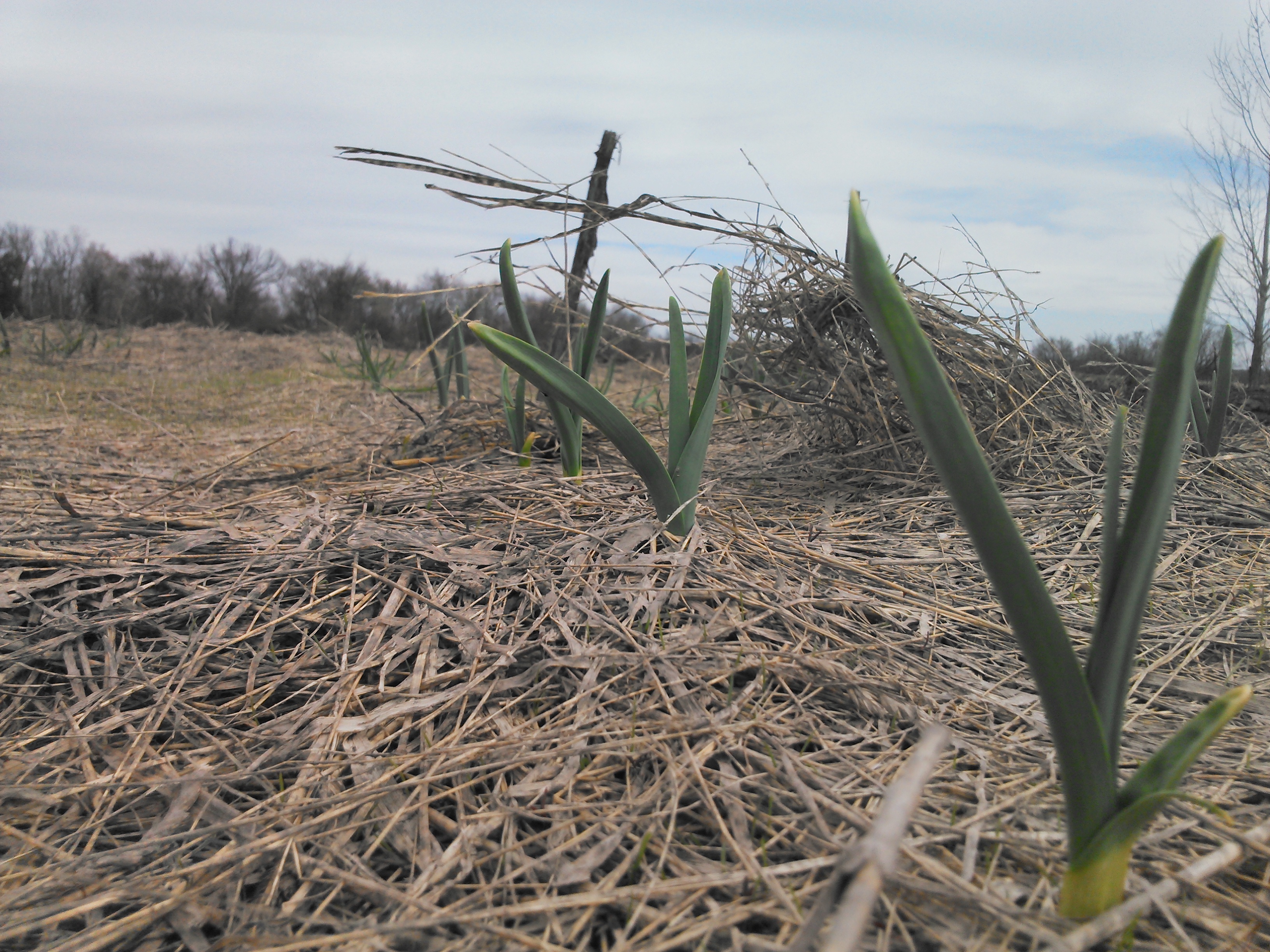
977.523.8
In the spring, garlic is one of the first things up. It is a welcome site for sore eyes. Before the weeds come, trees bud or grass greens up, there will be these glorious green garlic shoots popping out of some dreary colored mulch. At this time I check to make sure all can puncture their way through the mulch. If a thick clump of hay lands on top of a sprout, it might have difficulty reaching the light. That little clove only has so much energy and if the sprout has to turn sideways a few inches before breaking forth, it will be set back considerably or may not develop well at all.
Early in the growing season, keep the garlic consistently watered. It doesn’t appreciate being water logged, but don’t let it dry out. Also remove any competing weeds.
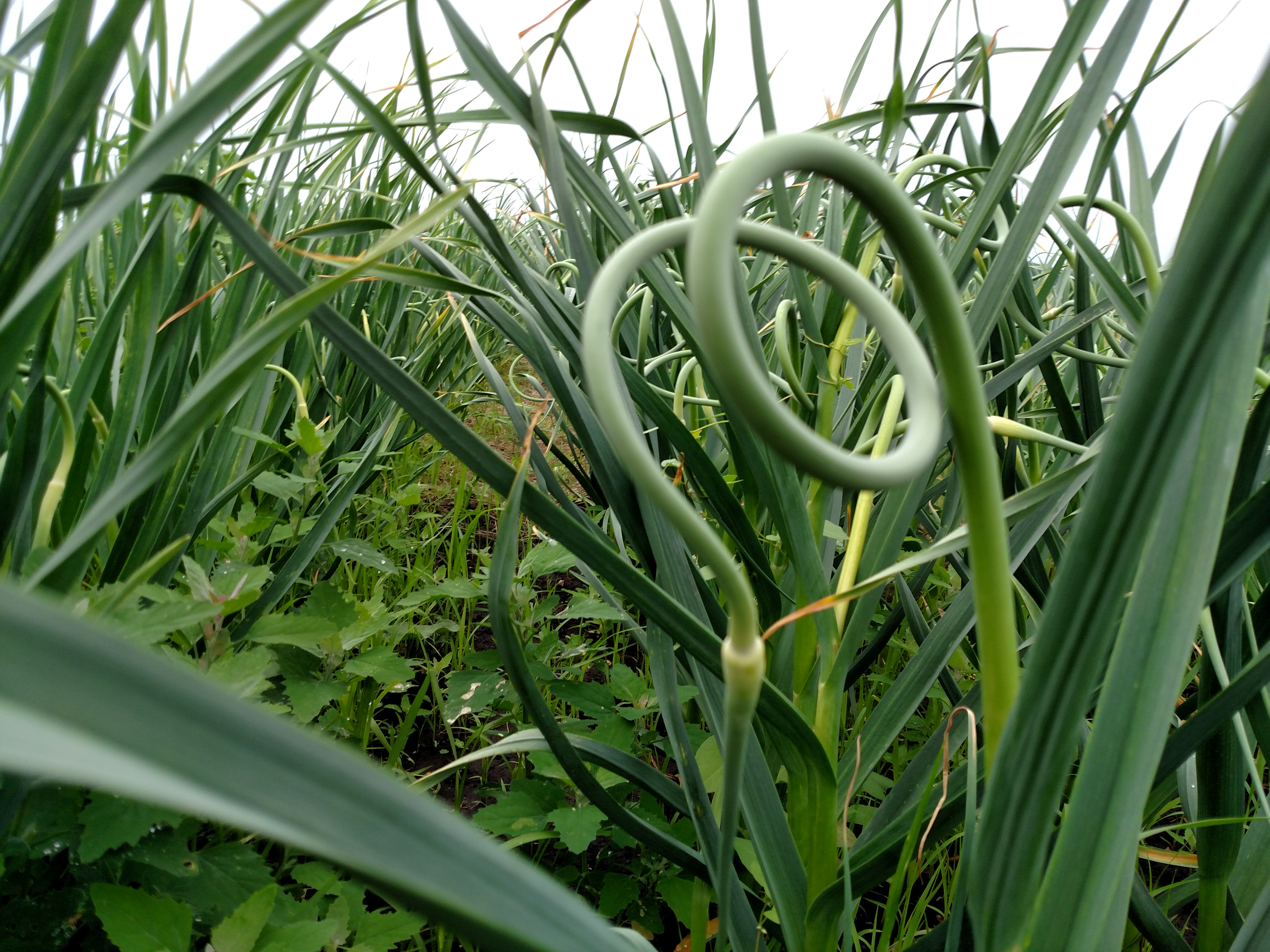 Come June, the hardnecks will begin the process of sending up their scapes. This are a great treat to get that hot garlic flavor before the garlic. Too many? Try making Pickled Garlic Scapes, they go great on Bloody Mary’s, so I been told. This is also the time that the garlic bulb is gaining weight. Some say to remove the scapes to help the bulb grow larger and I typically do. But some are always left and I find mixed results in the size. I think if soil moisture is adequate, weeds are removed and garlic is spaced properly, garlic with scapes can grow plenty big. But I like to stay on the safe side and remove them to let the plants put all their energy into the bulb. Its at this time you can begin to harvest garlic an eat it fresh. If your supply from last year is out, why not? Fresh garlic should be use quickly and stored under refrigeration when not used.
Come June, the hardnecks will begin the process of sending up their scapes. This are a great treat to get that hot garlic flavor before the garlic. Too many? Try making Pickled Garlic Scapes, they go great on Bloody Mary’s, so I been told. This is also the time that the garlic bulb is gaining weight. Some say to remove the scapes to help the bulb grow larger and I typically do. But some are always left and I find mixed results in the size. I think if soil moisture is adequate, weeds are removed and garlic is spaced properly, garlic with scapes can grow plenty big. But I like to stay on the safe side and remove them to let the plants put all their energy into the bulb. Its at this time you can begin to harvest garlic an eat it fresh. If your supply from last year is out, why not? Fresh garlic should be use quickly and stored under refrigeration when not used.
In July the garlic harvest begins. Look to the variety to know if it is an early, mid or late season type and harvest accordingly. For me, the softnecks are early while the hardnecks are later. This year, after a windstorm most of the softnecks bent over so I then harvested as I didn’t want them to begin rotting at the soil surface. The hardnecks waited until the bottom leaves were dry and there were only 4 or 5 leaves still green.
When harvesting, I always dig the garlic as I don’t want to break the stems or damage the bulbs. Hard soil can scrape or bruise garlic easily, diminishing shelf life. Garlic is then sorted for size as I pick out my largest, nicest bulbs for planting next years crop. It is bundled into groups of 8 to 12 heads and hung in an airy, dry place for curing. Some will just lay their garlic on racks as well.
After 2 or more weeks, depending on how green it was and how dry the air is, curing may be complete. the stems should be dry, a few outer skins should easily rub off and the garlic should have no smell. What? yes no smell. If it still smells of garlic it is not fully cured or may be damaged. I usually let mine go longer just be safe. But don’t go too long as you don’t want a fall rain to raise the humidity and encourage the garlic roots to begin growing. When ready, cut the stems a couple inches, trim roots, rub off easy to remove wrappers and store in a breathable bag in a dark coolish (55 degree) place with moderate humidity. Too low of humidity and the garlic will loose moisture and get rubbery. It is best to check the variety and determine which has the shortest shelf life and use that first. As a rule of thumb, softnecks last longer, hardnecks not so much. But we typically have all of our garlic make it to Easter with very little loss.
Overall, garlic is very gratifying to grow and the flavor of some high-quality, homegrown garlic variety trumps that boring Chinese stuff in the little boxes at the grocery store any day. If you are not going to use it all quickly, you could chop, dry and grind for garlic powder. Others will pack in oil, although I have seen some questions on the safety of doing so. If done improperly botulism could be an issue and we don’t want that.
But of course, don’t forget to plant some more for next year!

A Scape in the Sunset


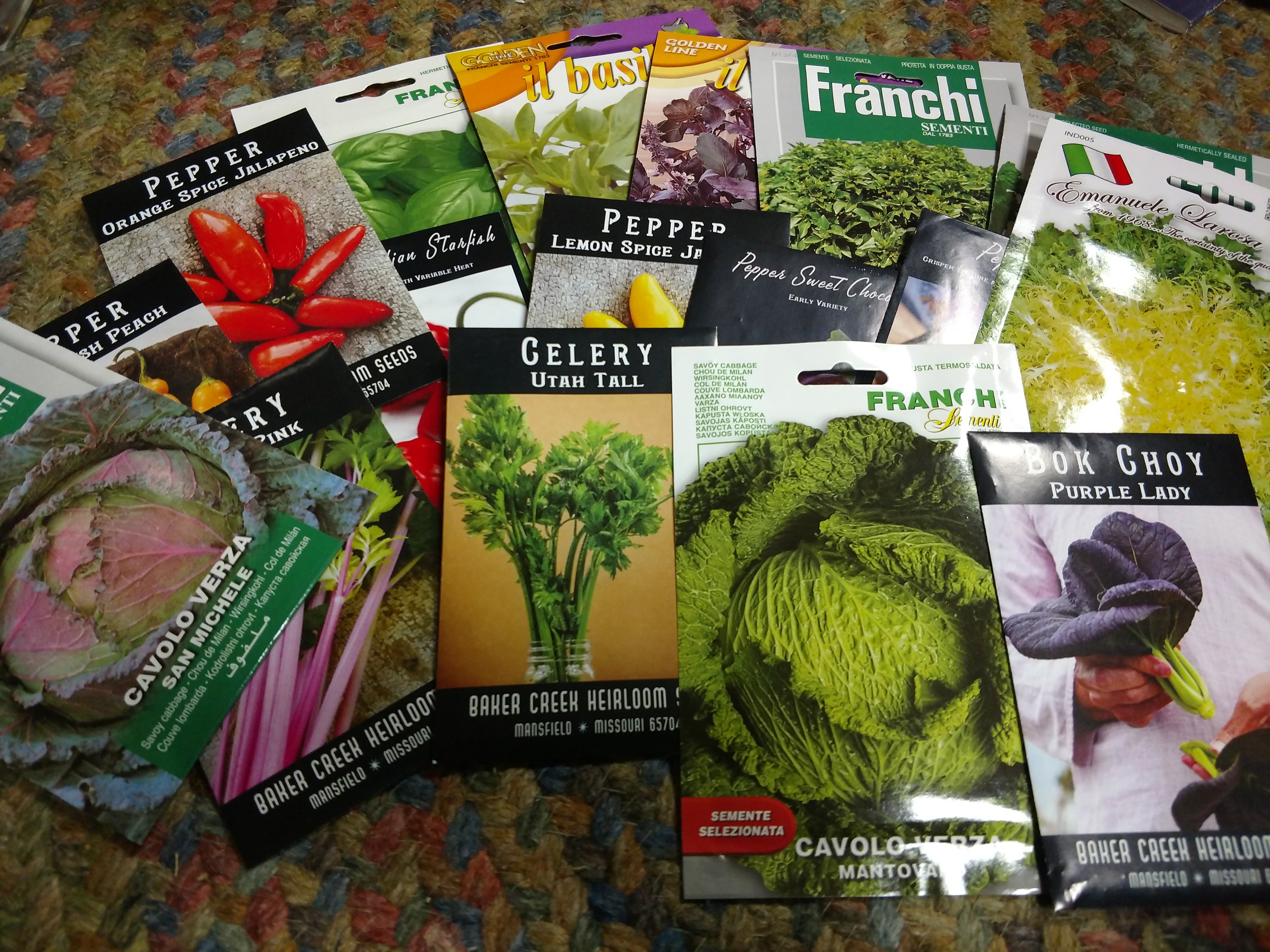
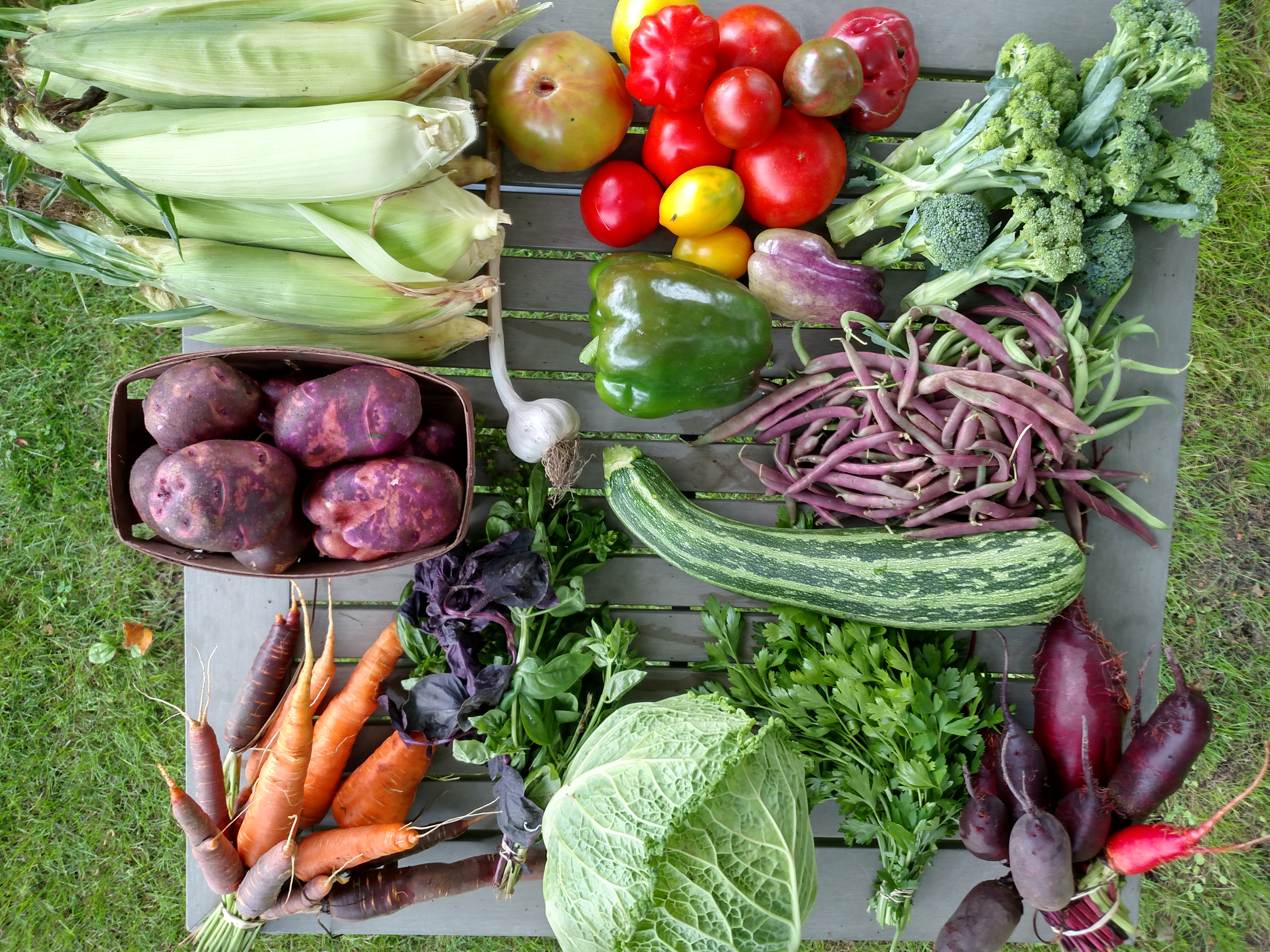 This time of year it always feels like summer has slipped by. But there is still so much to savor coming from the garden. The unseasonably wet summer has been great for some, not so great for others. The beans are producing like they are brand new, the cabbage and broccoli is in overdrive and the beets go on. For others, the wetness is getting to them. Digging up rotten potatoes, pulling up stinky rutabagas and climbing through disease laden tomatoes can get pretty frustrating, but with all the loss there is still an excellent crop of most things after a summer of growing.
This time of year it always feels like summer has slipped by. But there is still so much to savor coming from the garden. The unseasonably wet summer has been great for some, not so great for others. The beans are producing like they are brand new, the cabbage and broccoli is in overdrive and the beets go on. For others, the wetness is getting to them. Digging up rotten potatoes, pulling up stinky rutabagas and climbing through disease laden tomatoes can get pretty frustrating, but with all the loss there is still an excellent crop of most things after a summer of growing.


 Come June, the hardnecks will begin the process of sending up their scapes. This are a great treat to get that hot garlic flavor before the garlic. Too many? Try making
Come June, the hardnecks will begin the process of sending up their scapes. This are a great treat to get that hot garlic flavor before the garlic. Too many? Try making 



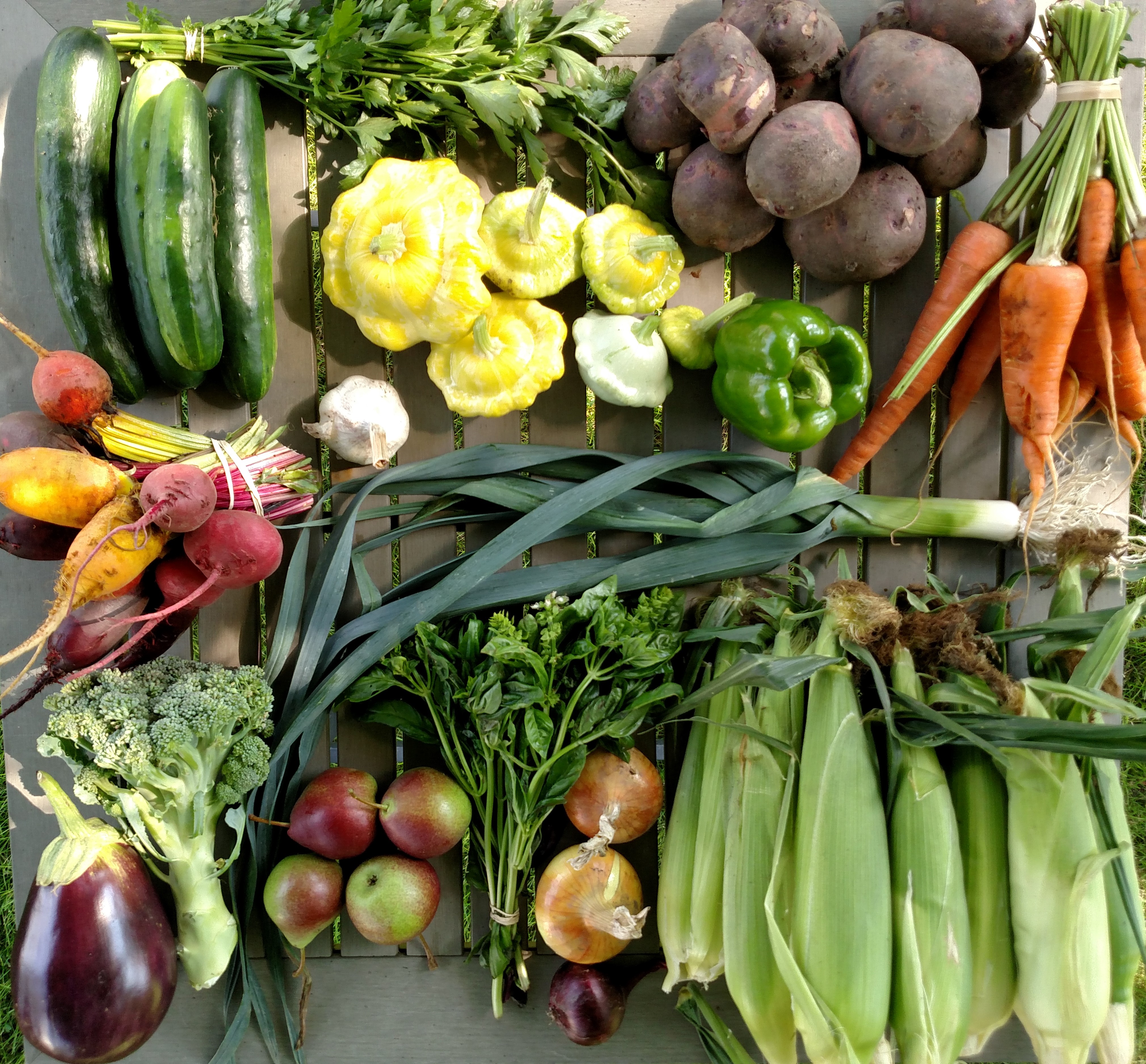 One of the most enjoyable aspects of eating seasonally, is about the time you are sick of something, you get a break. Now I know there are some things that people can eat all the time, we all have our favorites, but after weeks and weeks of beans and cabbage, there is a brief pause as we are between successions. This week some of you will be gifted a beautiful eggplant, others still get broccoli. Corn is full swing as are the cucumbers. There are a few prized bell peppers and a half dozen patty pan squash. Before too long we will be swimming in tomatoes and the squash will be coming in. But as each new crop becomes ready, for some reason my body really craves it. It is almost as though it is deprived of what ever nutrients they may have and it ready to soak them up. That first bowl of creamy cucumbers or corn on the cob taste like heaven.
One of the most enjoyable aspects of eating seasonally, is about the time you are sick of something, you get a break. Now I know there are some things that people can eat all the time, we all have our favorites, but after weeks and weeks of beans and cabbage, there is a brief pause as we are between successions. This week some of you will be gifted a beautiful eggplant, others still get broccoli. Corn is full swing as are the cucumbers. There are a few prized bell peppers and a half dozen patty pan squash. Before too long we will be swimming in tomatoes and the squash will be coming in. But as each new crop becomes ready, for some reason my body really craves it. It is almost as though it is deprived of what ever nutrients they may have and it ready to soak them up. That first bowl of creamy cucumbers or corn on the cob taste like heaven.











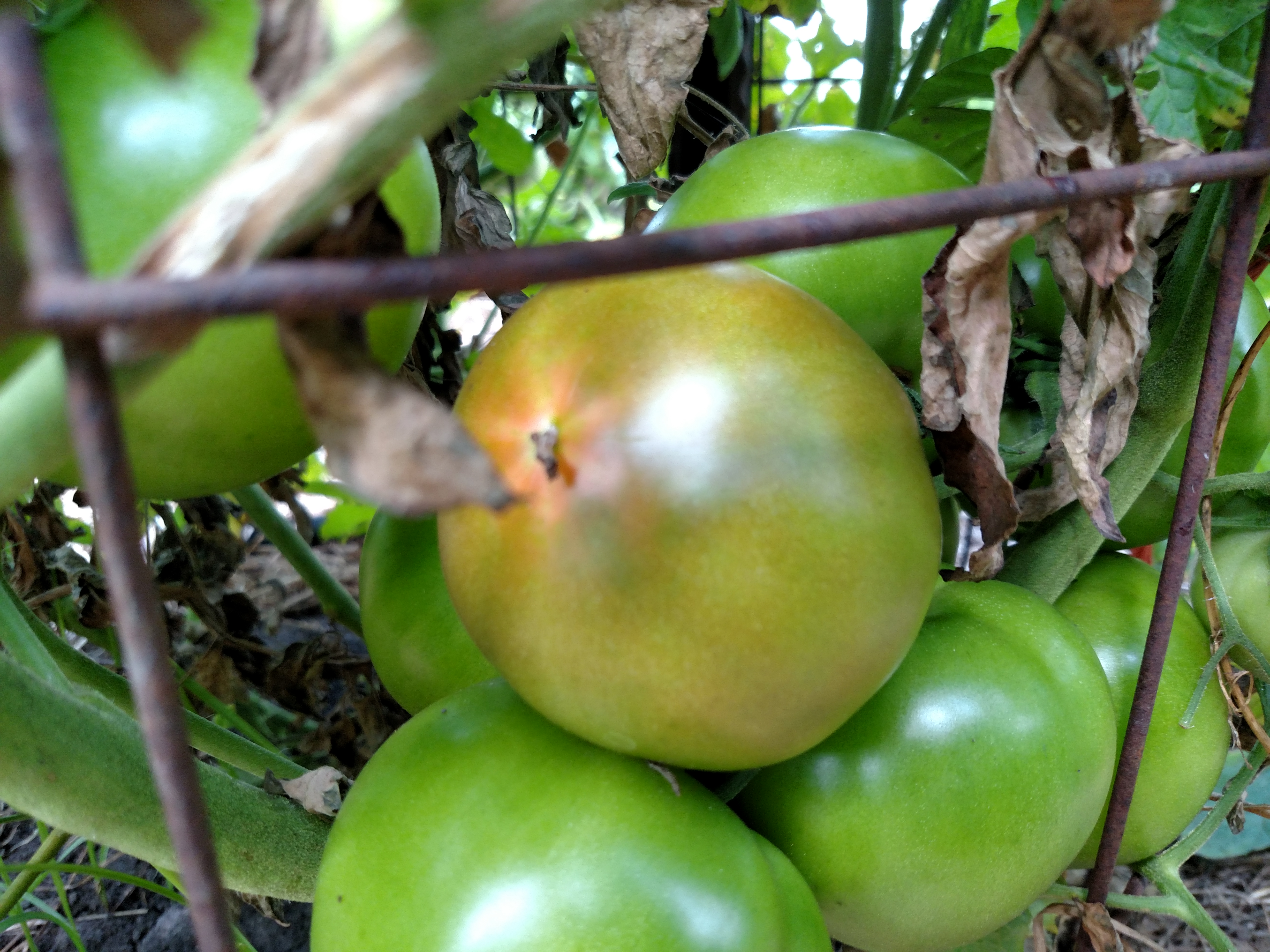
 All across rural America, midsummer means county fair season for lots of kids and their families. 4-H and FFA form the backbone to many rural communities because people see the value in supporting organizations that build positive habits in youth. Through showing livestock, exhibiting produce or taking on the technical tasks of sewing a dress or overhauling a tractor, parents know that their kids will learn how to work, plan, budget, care and speak. Sometimes kids win, but more often they don’t and both are huge learning opportunities.
All across rural America, midsummer means county fair season for lots of kids and their families. 4-H and FFA form the backbone to many rural communities because people see the value in supporting organizations that build positive habits in youth. Through showing livestock, exhibiting produce or taking on the technical tasks of sewing a dress or overhauling a tractor, parents know that their kids will learn how to work, plan, budget, care and speak. Sometimes kids win, but more often they don’t and both are huge learning opportunities.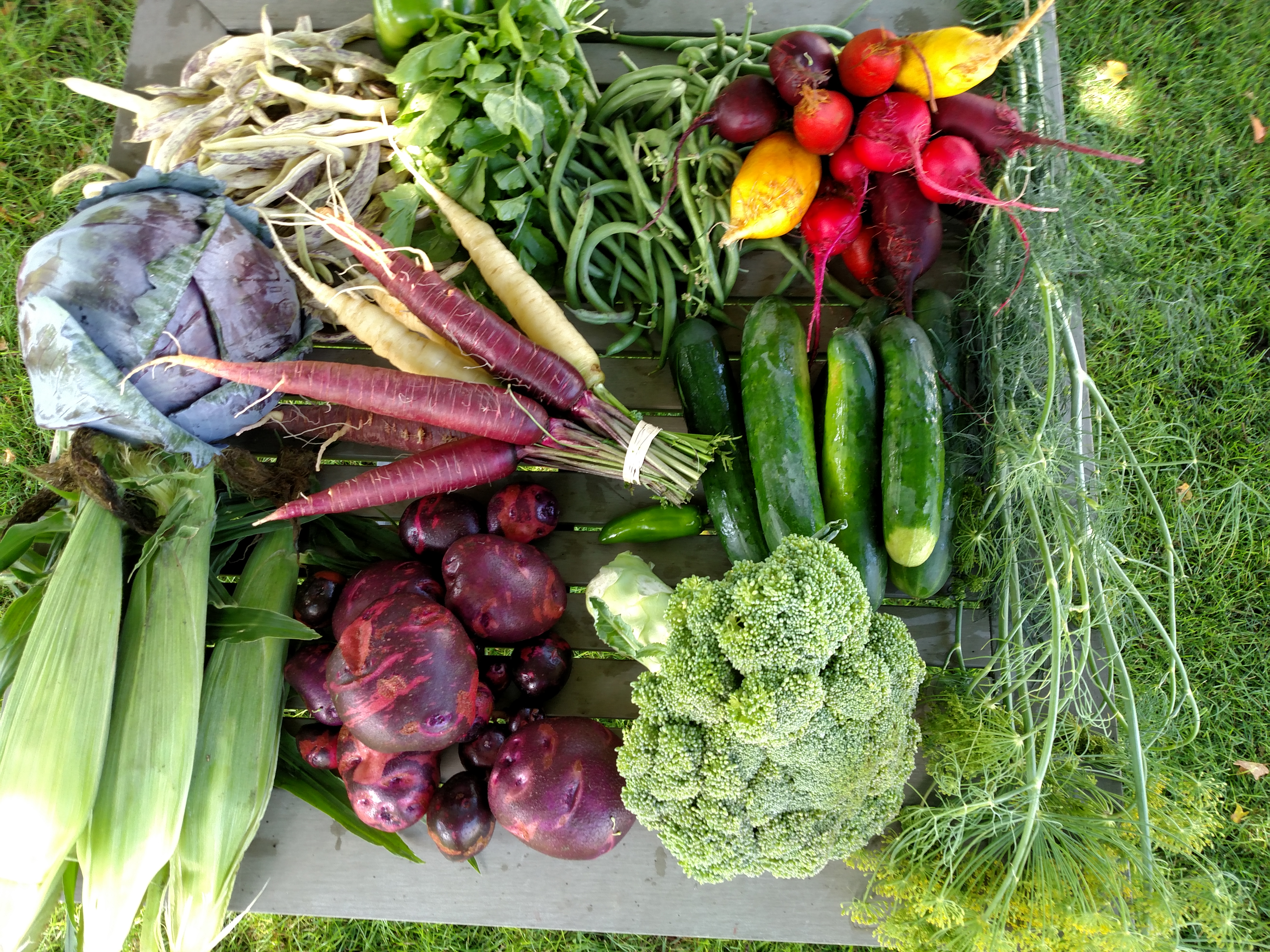 This week I got to take a peek at what kids did for their projects, especially the plant science exhibits. Planning a good vegetable exhibit is a lot like packing a CSA box. You need to have produce that looks good, is trimmed correctly, clean, and proper size. An added element is having a variety of types and colors to hit all the nutritional needs. While you might have a rocking assortment of greens and bean, people crave variety and each week I try to put together a mix that is appealing from first glance.
This week I got to take a peek at what kids did for their projects, especially the plant science exhibits. Planning a good vegetable exhibit is a lot like packing a CSA box. You need to have produce that looks good, is trimmed correctly, clean, and proper size. An added element is having a variety of types and colors to hit all the nutritional needs. While you might have a rocking assortment of greens and bean, people crave variety and each week I try to put together a mix that is appealing from first glance.